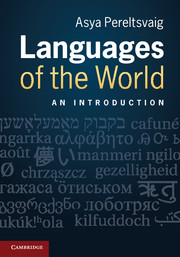Book contents
- Frontmatter
- Contents
- Figures
- Maps
- Tables
- Words, words, words…
- Acknowledgements
- Abbreviations used in the glosses
- 1 Introduction
- 2 Indo-European languages
- 3 Non-Indo-European languages of Europe and India
- 4 Languages of the Caucasus
- 5 Languages of Northern Africa, Middle East and Central Asia
- 6 Languages of sub-Saharan Africa
- 7 Languages of eastern Asia
- 8 Languages of the South Sea Islands
- 9 Aboriginal languages of Australia and Papua New Guinea
- 10 Native languages of the Americas
- 11 Macro families
- 12 Pidgins, creoles and other mixed languages
- Glossary
- References
- Index of languages
- Index of terms
1 - Introduction
- Frontmatter
- Contents
- Figures
- Maps
- Tables
- Words, words, words…
- Acknowledgements
- Abbreviations used in the glosses
- 1 Introduction
- 2 Indo-European languages
- 3 Non-Indo-European languages of Europe and India
- 4 Languages of the Caucasus
- 5 Languages of Northern Africa, Middle East and Central Asia
- 6 Languages of sub-Saharan Africa
- 7 Languages of eastern Asia
- 8 Languages of the South Sea Islands
- 9 Aboriginal languages of Australia and Papua New Guinea
- 10 Native languages of the Americas
- 11 Macro families
- 12 Pidgins, creoles and other mixed languages
- Glossary
- References
- Index of languages
- Index of terms
Summary
April 26, 1607. After a long 144 day voyage, three ships belonging to the Virginia Company of London and led by Captain John Smith make landfall at the southern edge of the mouth of the Chesapeake Bay, which they name Cape Henry. Shortly thereafter, they are forced to move their camp along the estuary, to a new location eventually known as “James Towne” or Jamestown, Virginia. Almost immediately, they encounter a group of “American Indians” who communicate with each other in what surely sounds like language, only it is quite different from the English of the Virginia Company settlers. Sure enough, there are words in this language and just like back home, people from different places pronounce the same words somewhat differently. But to an English ear, these words are unrecognizable: not only are there words for things unfamiliar to the English settlers (some of which will later be taken into the English language, like raccoon, moccasin, opossum and others), but even words for familiar objects and concepts sound different: for example, the word for ‘sun’ is either nepass or keshowghes and the word for ‘copper’ is either matassen or osawas. And it is not just the words that are different, but so is the way the words are put together: for example, grammatical objects in this language typically precede rather than follow the verb. This pattern would not have surprised the settlers, had they come from the Basque country or Turkey or Japan, or even had they arrived 700 years earlier, but for the Virginia Company men it must have been a striking pattern. The differences between the language of these “American Indians” and English are so ear-grating that the English settlers start compiling lists of “American Indian” words: Captain John Smith himself compiles a list of about fifty words and William Strachey publishes a “dictionary” of the language containing about 1,000 words. Today, most of what we know about this language – called Powhatan and attributed to the Eastern Algonquian branch of the Algonquian language family (see Chapter 10) – derives from the descriptions of seventeenth- and eighteenth-century writers, as the language died in the 1790s when its speakers switched to English.
Information
- Type
- Chapter
- Information
- Languages of the WorldAn Introduction, pp. 1 - 12Publisher: Cambridge University PressPrint publication year: 2012
